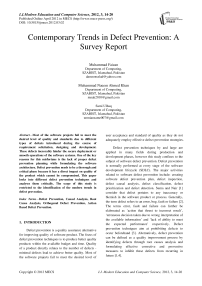Contemporary Trends in Defect Prevention: A Survey Report
Автор: Muhammad Faizan, Muhammad Naeem Ahmed Khan, Sami Ulhaq
Журнал: International Journal of Modern Education and Computer Science (IJMECS) @ijmecs
Статья в выпуске: 3 vol.4, 2012 года.
Бесплатный доступ
Most of the software projects fail to meet the desired level of quality and standards due to different types of defects introduced during the course of requirement solicitation, designing and development. These defects inexorably hinder the secure deployment or smooth operations of the software systems. One of the key reasons for this misfortune is the lack of proper defect prevention planning while formulating the software architecture. Defect prevention needs to be a thorough and critical phase because it has a direct impact on quality of the product which cannot be compromised. This paper looks into different defect prevention techniques and analyses them critically. The scope of this study is restricted to the identification of the modern trends in defect prevention.
Defect Prevention, Causal Analysis, Root Cause Analysis, Orthogonal Defect Prevention, Action Based Defect Prevention.
Короткий адрес: https://sciup.org/15010682
IDR: 15010682
Список литературы Contemporary Trends in Defect Prevention: A Survey Report
- V. Suma and T. R. G. K. Nair, “Effective Defect Prevention Approach in Software Process for Achieving Better Quality Levels,” World Academy of Science, Engineering and Technology (WASET), 42, pp. 258_262, 2008.
- B. Clark and D. Zubrow, How Good Is the Software: A review of Defect Prediction Techniques, sponsored by the U.S. department of Defense by Carnegie Mellon University, version 1.0, page 5, 2001.
- C. P. Chang and C. P. Chu., Defect prevention in software processes: An action based approach, The Journal of Systems and Software 80, 559–570, 2007.
- S. Kumaresh and R. Baskaran, Defect Analysis and Prevention for Software Process Quality Improvement, International Journal of Computer Applications, Volume 8– No.7, pp. 42_47, 2010.
- M. Kalinoski, G. H. Travassos and D. N. Card., “Towards a Defect Prevention Based Process Improvement Approach,” 34th Euromicro Conference Software Engineering and Advanced Applications (SEAA), IEEE Computer Society, pp. 199_206, 2010.
- P. Trivedi. & S. Pachori, Modeling and Analysis of Software Defect Prevention Using ODC, International Journal of Advanced Computer Science and Applications (IJACSA), Vol. 1, No. 3, pp. 75_77, 2010.
- A. Shenvi, “Defect Prevention with Orthogonal Defect Classification,” International Software Engineering Conference (ISEC’09), ACM, pp. 83_87, 2009.
- P. Tiejun, Z. Leina and F. C. bin., “Defect Tracing System Based on Orthogonal Defect Classification,” International Conference on Computer Science and Software Engineering (CSSE), IEEE, pp. 574_577, 2008.
- E. Bean, Defect Prevention and Detection in Software for Automated Test Equipment,” Instrumentation & Measurement Magazine, IEEE, Volume: 11 Issue: 4, pp. 16_23, 2008.
- M. Li, H. Xiaoyuan and A. Sontakke, “Defect Prevention: A General Framework and Its Application”, Proceedings of the sixth International Conference on Quality Software (QSIC’06), IEEE Computer Society, 2006.
- V. Suma and T. R. G. K. Nair, “Enhanced Approaches in Defect Detection and Prevention Strategies in Small and Medium Scale Industries,” Third International Conference on Software Engineering Advances (ICSEA), IEEE Computer Society, pp. 389_393, 2008.
- C. P. Chang and C. P. Chu, Defect prevention in software processes: An action based approach, The Journal of Systems and Software 80,559–570, 2007.
- G. Mujtaba, Dr. T. Mahmood and Professor Z. Nasir, A Holistic Approach to Software Defect Analysis and Management, Australian Journal of Basic and Applied Sciences, 5(6), 1632_1640, 2011.
- G. J. Holzmann and R. Joshi, Reliable Software Systems Design: Defect Prevention, Detection, and Containment, International Federation for Information Processing (IFIP). LNCS 4171, pp. 237_244, 2008.
- A. Ghazarian, “A Case Study of Defect Introduction Mechanisms”, Conference on Advanced information Systems Engineering (CAiSE), LNCS 5565, pp.156–170, Springer Verlag Berlin Heidelberg, (2009).
- M. Jantti, T. Toroi and A. Eerola, “Difficulties in Establishing a Defect Management Process: A Case Study”, International Conference on Product Focused Software Development And Process Improvement (PROFES’06), LNCS 4034, pp.142–150, Springer Verlag Berlin Heidelberg, (2006).


